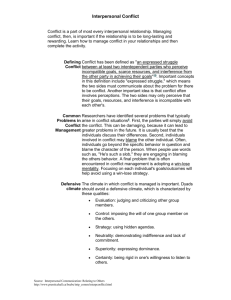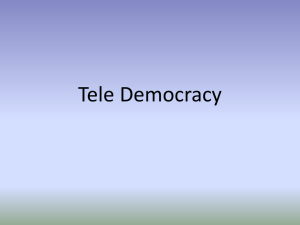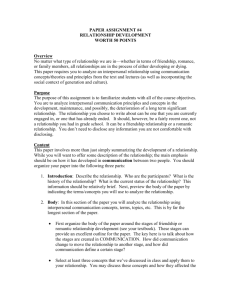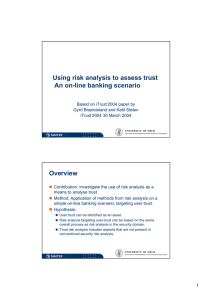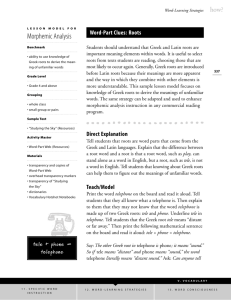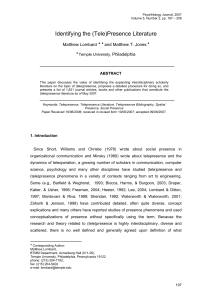TELE 350 Lectures 1-3
advertisement
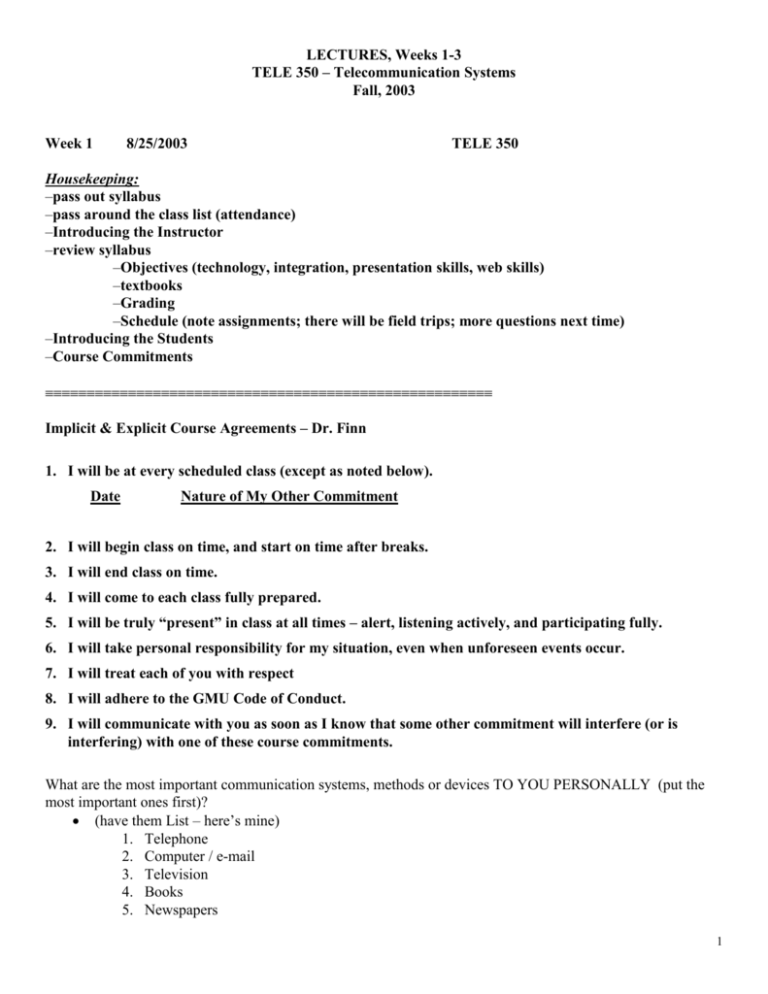
LECTURES, Weeks 1-3 TELE 350 – Telecommunication Systems Fall, 2003 Week 1 8/25/2003 TELE 350 Housekeeping: –pass out syllabus –pass around the class list (attendance) –Introducing the Instructor –review syllabus –Objectives (technology, integration, presentation skills, web skills) –textbooks –Grading –Schedule (note assignments; there will be field trips; more questions next time) –Introducing the Students –Course Commitments Implicit & Explicit Course Agreements – Dr. Finn 1. I will be at every scheduled class (except as noted below). Date Nature of My Other Commitment 2. I will begin class on time, and start on time after breaks. 3. I will end class on time. 4. I will come to each class fully prepared. 5. I will be truly “present” in class at all times – alert, listening actively, and participating fully. 6. I will take personal responsibility for my situation, even when unforeseen events occur. 7. I will treat each of you with respect 8. I will adhere to the GMU Code of Conduct. 9. I will communicate with you as soon as I know that some other commitment will interfere (or is interfering) with one of these course commitments. What are the most important communication systems, methods or devices TO YOU PERSONALLY (put the most important ones first)? (have them List – here’s mine) 1. Telephone 2. Computer / e-mail 3. Television 4. Books 5. Newspapers 1 Overview of Semester: –dizzying array of technologies –hard to make sense w/o roadmap –we’ll use several roadmaps: –Interpersonal vs. Mass –Personal vs. Impersonal –Information Sys vs. Communication Sys –10 Attributes – Examples: Mass Comm –Newspapers –Magazines –Books –Phonograph –Movies –Broadcast Radio –Broadcast TV –Cable TV –Audio Cassettes, CDs –Videocassettes –New Wireless Technologies –New Wired Technologies –On-Line Newspapers –Computers, Internet, WWW Examples: Interpersonal Comm –Face To Face –Letters –Telegraph –Telephone –Radio (Ship, Short-wave, CB) –E-Mail –Answering Machines –Voice Mail –Fax –Video Conferencing –Video Phone –Computers –Internet, WWW Overview of Telecommunications Tele - “At A Distance” 2 Telecommunications –(Electronic) Comm At A Distance –“Mediated” The Field of Communication –Interpersonal –Small Group –Large Group –Organizational –Mass Mass Communication –One Way –No Direct Feedback –1 To Many (Millions?) –Dispersed Audience –Edited / Packaged –Impersonal Interpersonal Communication –Two Way –Feedback –1 To 1, 1 To Many –Not “Packaged” –Personal Mass / Interpersonal Communication –Mass, Interpersonal Theories; where do “new technologies” fit? –One-way, two-way –1 to 1, 1 to many, many to many –mass: dispersed receivers –Personal / impersonal communication S-M-C-R Model of Communication –Source –Message –Channel (w/ encoding before and decoding after) –Receiver Plus: –Feedback (to regulate flow of comm) –Noise (distortion/errors) Technical and Non-technical Internet Structures Related to Personal Communication Emoticons Acronyms Netiquette 3 Anonymous Remailers Public Key Encryption E-mail: POP Implementations E-mail: IMAP Implementations Listservs Newsgroups Computer Conferencing NOT Related to Personal Communication Spam Cookies Virus Hoaxes Urban Legends Firewalls Software Filters Carnivore Gopher, ftp & telnet Internet Addiction Evaluating Source Credibility Opt In vs. Opt Out Search Engines Areas Of Telecommunications –The Technology –Policy & Regulation –Industry Structure –Economics Of The Media –The Production Of Messages –Effects Of The Media –On Individuals –On Groups On Society Components of a Computer Network CPU / Server(s) Conduit (Transmission media; “pipe”) Terminals Peripherals Class Exercise 1a List as many terminal devices as you can. Organize then in categories that make sense to you. First do individually 4 Then in a group (of 3) Computer Technology Components Of A Computer Network –CPU –Processing –Storage Device –Transmission Medium / Conduit –Terminal Devices –Peripherals Traditional Types Of Computers –Mainframes –Mini-Computers –Micro-Computers New Classifications –Servers –“Mainframes” Disappearing –Client-Server –Terminals, Printers, Other Peripherals & Output Devices 4 Types Of Computer “Capacity” –Storage Capacity –Access Speed –Processing Speed –Transmission Rate Five Trends In Computing –Increased Speed –Increased Capacity –Miniaturization –Decentralization –End-User Control Computers (Continued) Storage And Processing: The Heart Of The Digital Computer –A Bit: –A Byte: –A Kilobyte: –A Megabyte: –A Gigabyte: My PCs –Storage: A 0 Or 1 8 Bits (00000001) 256 Possible Arrangements 1,000 Bytes (1,024) 1/2 Page Text 1,000,000 Bytes 500 Pages 1 Billion Bytes 500,000 Pages From NO hard drive, to 10 Mb, 20 Mb, 340 Mb, 3.2 Gb, 5 Processing: 20 Gb, 80Gb, 160Gb From Clock Speed of: 33 KHz, to 80, 200, 650 KHz, 2.24 MHz Fiber: –Today: 2.5 Gb/Sec –New Fiber: 80, 160 Gb Week 2 1.25m Pages 40m, 80m Pages 9/8/2003 TELE 350 Housekeeping: review syllabus questions? Contact Sheet Due Week 4: Critique 1 History Of Telephony Regulation, AT&T, & Industry Structure History of Common Carrier –Telegraph: Invented 1844 –Telephone: Invented 1876 –Intercom Uses –Music Uses –Invention of Switching –Long-Distance –Rise of AT&T –AT&T’s “Natural Monopoly” –1913 Anti-Trust Action Led to “Kingsbury Commitment” AT&T Promised To: Stop Unfair Practices (Refusal to Interconnect) Pursue Universal Service 1925: Bell Labs Founded History Of Telephony Regulation, AT&T, & Industry Structure (Con’t) AT&T Made up of 4 Components: 22 BOCs Local Phone Service Long Lines Long Distance Service Western Electric Equip. Manufacturing Bell Laboratories R&D –1949-56 Anti-Trust Action 6 Gov’t Stopped Effort To Break Up AT&T AT&T Agreed To Stay Out Of Computers –1968 Carterfone Decision Competition In The Equipment Business –1969 MCI Decision Competition In The Transmission (LD) Business –1974 Anti Trust Action Started –Vertical & Horizontal Monopoly –Gov’t Wanted AT&T To Give Up Western Electric (Equipment Business) History Of Telephony Regulation, AT&T, & Industry Structure (Con’t) 1981 Computer Inquiry II Decision –Computer Companies Were Transmitting Data Over Phone Lines –Could Continue Offering “Enhanced Services” - Unregulated –AT&T Could Offer “Enhanced Services” And CPE - Under A Separate Subsidiary –1974-82 Anti-Trust Action 1984 Divestiture –AT&T Keeps LD, WE, & Labs; Spin Off Bocs –AT&T Keeps 400,000 Employees, 600,000 Go With BOCs –AT&T Keep $40 B In Assets, Gives Up $60 B –22 BOCs Re-Organized Into 7 RBOCs –NYNEX, Bell Atlantic, Bell South, Ameritech, US West, S. Western Bell, & Pacific Telesis History Of Telephony Regulation, AT&T, & Industry Structure (con’t) –RBOCs Not Allowed To: – Manufacture Equipment –Get Into LD –Offer Enhanced Services –RBOCs Keep Yellow Pages, Pay Phones –Telecomm Act Of 1996 –“Open Competition” –Re-Regulation (Not De-Regulation!) –Cable, Local Phone And LD Companies Can Offer Each Other’s Services –“Once there is Competition” –Comm Decency Act Of 1996 –V-Chip (Television) Proposal –Banned “Indecency” On The Internet 7 Ten Attributes Common to ALL Communication & Information Technology (CIT) Type of Content Text Audio Still Image Moving Image Raw Data Implications: Bandwidth, User Interface Directionality One-Way Two-Way Implications: Degree of Non-Simultaneity Degree of Non-Simultaneity Simultaneous / Non-Simultaneous Dichotomy Then, Varying Degrees of Non-Simultaneity Implications: Storage Type of Conduit Wired Wireless Implications: Impacts Degree of Mobility Analog / Digital Representation Analog Digital Implications: Storage Capabilities Transmission Capabilities Access Points One to One One to Many One to One Many Times Over (Rather than Many to Many) Implications: Number of Simultaneous Users 8 Type of Connection Switched Networked Broadcast Implications: Directionality Degree of Non-Simultaneity Bandwidth Narrowband Baseband Broadband Implications: Impacts Transmission Speed Storage Content Preservability Content Retrievability Content Searchability Content Modifiability Implications: Impacts Ease of Use Impacts Flexibility & User Control User Interface Type of Content Addressed Input / Output Devices Feature Richness Feature Operation System Navigation Implications: Impacts Ease of Use Impacts Mobility Note: –Very Few Technologies are “Pure” Examples –Most are Hybrid Class Exercise 2 Name 1-4 Technologies (Systems) that fit in each of the 4 boxes below. 9 One Way Two-Way Simultaneous Non-Simultaneous Week 3 9/15/2003 TELE 350 Housekeeping: Introduce new student(s) Due Week 4: Critique 1 Discuss Web Assignments Level of web design experience? To sign up for STARS Center Courses go to http://media.gmu.edu/workshops/ Upcoming courses of interest to TELE 350 Create & Upload a Basic Web Page (9/15, 7:30 pm) Dreamweaver I (9/18, 10:30 am) Lecture Finish History of Common Carrier 10 Attributes Class Exercise 3 List ALL the basic consumer choices people must make when ordering: 1. Home (land line) telephone service 2. Cell (wireless) telephone service Organize these into categories of decisions (it may help to think about the questions a sales rep might ask the consumer). 10
